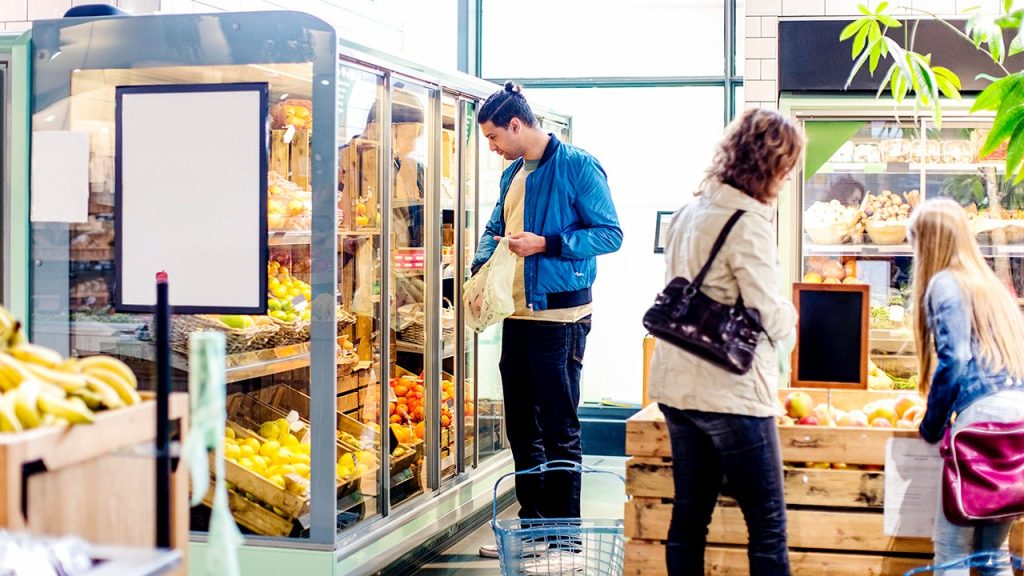Credit card rewards can be a perk of holding a card and using it responsibly, and they can come in the form of miles, points or cash back rewards that return a percentage of your purchases in the form of cash. For instance, the Blue Cash Preferred® Card from American Express offers 6 percent cash back on U.S. supermarket purchases (on up to $6,000 per year, then 1 percent back).
Reader Ruben writes that his Discover credit card offers 5 percent cash back for grocery purchases, and he wonders which purchases qualify. Since Ruben didn’t clarify which Discover card, we’ll assume they mean the Discover it® Cash Back, which offers 5 percent cash back on rotating categories each quarter on up to $1,500 per quarter (activation required), then 1 percent back. “Grocery stores” are frequently featured as one of the card’s rotating categories.
“I just have a general question about cash back resulting in the groceries category,” Ruben says. “When they say ‘groceries,’ do they mean strictly food-related items — or can other items sold (say, at a Ralph’s) also be counted toward the cash back rewards? I mainly want to know for the 5 percent cash back my current Discover credit card holds. Am I receiving the 5 percent on all purchases at the grocery store, or are some items deemed 1 percent cash back?”
Check the merchant category code for the retailer
Card issuers assign different categories — called merchant category codes — based on what sort of business the merchant is in. These merchant category codes determine which retailers qualify for specific rewards categories. These categories could include restaurants, grocery stores, gas stations, department stores, home improvement stores and office supply stores. Some merchants may not qualify for cash back rewards in a certain category, even though you might think they do.
For instance, Chase explains that restaurants qualify for the dining category if the “merchants’ primary business is sit-down or eat-in dining, including fast food restaurants and fine dining establishments…Delivery and takeout services will be included if they classify as a restaurant merchant.”
This means if you make purchases from merchants selling food and drink that operate within the following venue types, these purchases may not qualify to earn cash back rewards under the restaurant category:
- Sports stadiums
- Casinos
- Theme parks
- Grocery stores
- Hotels
- Department stores
Only if the merchant has set up such purchases to be classified in the restaurant category will you get cash back rewards under the restaurant category.
What purchases most often count towards grocery rewards?
Ruben, what you need to know is whether Discover classifies a store you’re interested in as a grocery store. If so, the purchases you make at that store would qualify for grocery cash back rewards. The rewards would apply to other purchases besides food items, too.
Discover explains which types of stores qualify for grocery rewards. According to Discover’s Cash Back Calendar’s terms and conditions, “Grocery Store purchases include those made at supermarkets, meat lockers, bakeries, smaller grocery stores, and grocery delivery services.”
According to Chase, its grocery store category includes “supermarkets, merchants that offer a full-service grocery line of merchandise including a deli and bakery as well as smaller grocery stores” and “delivery service merchants will be included if they classify as a grocery store merchant.”
What purchases do not count towards grocery rewards?
For the Discover it Cash Back, “All purchases made at Walmart, Target, convenience stores, wholesale clubs, discount stores, and supercenters are not eligible” for grocery rewards, according to the issuer’s terms and conditions.
Chase doesn’t count warehouse stores and discount stores like Target or Walmart, which sell a large range of goods, including groceries, in this category. Drugstores and merchants that sell only a few grocery items may not qualify for grocery store cash back rewards either. And if you buy groceries at a gas station, that doesn’t count for grocery store cash back rewards.
Other issuers may define “grocery stores” differently. If you have a card that offers rewards on groceries or at grocery stores, check the fine print of your rewards program or cardholder agreement. There’s a good chance the issuer will tell you exactly what does and doesn’t count. For example, here are the terms and conditions of the Capital One Savor Cash Rewards Credit Card* and the Blue Cash Preferred® Card from American Express, two other popular cards with bonus points on grocery store or U.S. supermarket purchases.
The bottom line
Card issuers classify retailers into various merchant category codes based on the business type. This determines whether you get rewards under a specific category for shopping at a certain store.
In general, if a store is classified as a grocery store, and you have a credit card that rewards grocery purchases, you should be rewarded for the grocery category for purchases besides groceries made at that store. Ruben, check with your issuer to see if the store you prefer qualifies for grocery cash back rewards.
But even if it does, that doesn’t mean you should stock up on all sorts of purchases from your preferred grocery store just to qualify for grocery cash back rewards. Other stores that specialize in hardware items, for example, might offer a better price for such items than your local grocery store. If you bought hardware items from a grocery store, you may be paying a higher price — even after accounting for any cash back rewards earned.
The information about the Capital One Savor Cash Rewards Credit Card has been collected independently by Bankrate. The card details have not been reviewed or approved by the issuer.
Read the full article here










